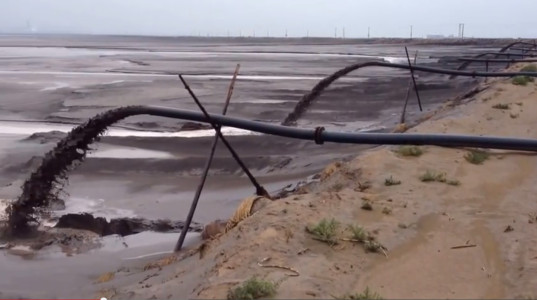Für alle elektronischen Geräte gilt eines: in jedem stecken „Selten Erden“, Metalle, die inzwischen unerlässlich für deren Herstellung und Funktion sind. Sie kommen aber nicht nur in elektronischen Geräten zum Einsatz, sondern auch in Windturbinen, Hybrid- und Elektrofahrzeugen.
Baogang Steel and Rare Earth Complex
Beinahe der gesamte Weltbedarf an Seltenen Erden wird derzeit von China gedeckt. China kontrolliert etwa 95% der Produktion. Von diesen 95% stammen zusammengerechnet 70% aus einer einzigen Anlage: Der Baogang Steel and Rare Earth Complex in der Inneren Mongolei, der seit 1954 besteht. Auf ihrer Homepage findet man folgende Aussage:
„Baogang has been appointed as one of the first group recycling experimental units and established the eco-industrial park. It is the first company that uses the blast furnace dry dedusting method in this industry. Baogang takes the first place in Chinese top 50 Energy Green Enterprises Award.“
Wie die Methoden der Abfallentsorgung aussehen, die der Gewinner eines chinesischen Umwelt-Unternehmen-Preises, davon hat sich der britische BBC-Reporter Tim Maughan überzeugt. Er schreibt in seinem Artikel „The dystopian lake filled by the world’s tech lust“:
„From where I’m standing, the city-sized Baogang Steel and Rare Earth complex dominates the horizon, its endless cooling towers and chimneys reaching up into grey, washed-out sky. Between it and me, stretching into the distance, lies an artificial lake filled with a black, barely-liquid, toxic sludge.“
Wie das aussieht?
httpv://youtu.be/t_UdqZdFr-w
Bei dem Anblick vergeht mir rasch die Lust auf neue Elektronikspielereien. Das schiere Ausmaß an sichtbaren Umweltschäden ist vergleichbar mit der kanadischen Teersand-Produktion. Gerade in Österreich grenzt die Zerstörung an die Unvorstellbarkeit. Die Abhängigkeit von elektronischen Geräten erscheint als das, was sie ist: krankhaft.
Tim Maughan schreibt:
„I’d seen some photos before I left for Inner Mongolia, but nothing prepared me for the sight. It’s a truly alien environment, dystopian and horrifying. The thought that it is man-made depressed and terrified me, as did the realisation that this was the byproduct not just of the consumer electronics in my pocket, but also green technologies like wind turbines and electric cars that we get so smugly excited about in the West. Unsure of quite how to react, I take photos and shoot video on my cerium polished iPhone.“
Vielleicht kann das nächste iPhone dann doch noch etwas warten.









